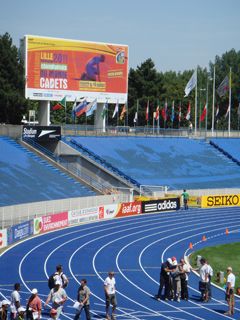To guard against heat illnesses, NATA recommends following these easy steps:
- Gradually increase activity in terms of intensity and duration in the heat. This prepares your body for more intense, longer duration exercise in warm conditions, and helps prevent injury and heat illness.
- Intersperse periods of rest during activity and assure adequate rest between exercise bouts. Rest breaks are an important defense against heat illness, and proper sleeping habits decrease your risk as well.
- Begin outdoor activities only after you’re properly hydrated. Drink water or sports drinks throughout physical activity in the heat.
- A darker urine color is a quick indicator of dehydration. Your urine should look more like lemonade than apple juice.
- Exercise during cooler portions of the day (early morning or late evening), if possible.
- Do not participate in intense exercise if you show signs of an existing illness (i.e. fever, diarrhea, extreme fatigue, etc.). These can decrease your body’s tolerance for heat and increase your risk of a heat illness. Back off on exercise intensity or duration if not feeling well (i.e. walk instead of run, cut the session short, etc.)
- Athletic events should employ an athletic trainer for coverage to assure proper medical supervision, recognition and treatment of possible injuries and heat illness.
“We are not invincible when it comes to exercise in the heat” said McDermott. “In extreme cases, if medical care is not provided in a timely manner, long-term damage can occur.”
Following is an overview of the heat-related ailments to be aware of when working or playing in the heat:
- Exertional Heat stroke is an extremely serious illness that can result in death unless quickly recognized and properly treated. Signs and symptoms include an increase in core body temperature (usually above 104°F/40°C); central nervous system dysfunction, such as altered consciousness, seizures, confusion, emotional instability, irrational behavior or decreased mental acuity; nausea, vomiting, or diarrhea; headache, dizziness, or weakness; increased heart rate; decreased blood pressure or fast breathing; dehydration; and combativeness.
What to do: It’s very important that treatment for exertional heat stroke be both aggressive and immediate, provided adequate medical personnel are on site. Key steps to take when exertional heat stroke is identified include immediate whole-body cooling, preferably through cold-water immersion, followed immediately by medical treatment in an emergency room or trauma center.
- Heat exhaustion is a moderately serious illness resulting from fluid loss or sodium loss in the heat. Signs and symptoms include loss of coordination; dizziness or fainting; profuse sweating or pale skin; headache, nausea, vomiting or diarrhea; stomach/intestinal cramps or persistent muscle cramps.
What to do: Heat exhaustion patients should immediately be transported to a cool, shaded environment with feet elevated, and fluids should be replaced. If their condition worsens or does not improve within minutes, they should be transported to the emergency room for evaluation and treatment. Those suffering from heat exhaustion should avoid intense activity in the heat until at least the next day. NATA also recommends a trip to the doctor to rule out any underlying conditions that predispose them to heat exhaustion.
- Heat cramps are often present in those who perform strenuous exercise in the heat. Conversely, cramps also occur in the absence of warm or hot conditions, which is common in ice hockey players. Signs and symptoms include intense pain (not associated with pulling or straining a muscle) and persistent muscle contractions that continue during and after exercise.
What to do: People suffering from heat cramps should cease activity, consume high sodium food and stretch the affected muscle. They should also be assessed by an athletic trainer to determine if they can return to activity. If cramping progresses in severity or number of muscle groups, patients should be transported to the emergency room for more advanced treatment.
- Hyponatremia is a potentially fatal illness that occurs when a person’s blood sodium levels decrease, either due to over-hydration or inadequate sodium intake, or both. Medical complications can result in cerebral and/or pulmonary edema. Signs and symptoms of this illness include excessive fluid consumption before, during and after exercising (weight gain during activity); increasing headache; nausea and vomiting (often repetitive); and swelling of extremities (hands and feet).
What to do: Hyponatremia cases that involve mental confusion and intense headache should be seen by a physician so proper treatment can be administered. A physician should also be consulted prior to resuming outdoor activity in the heat. Always listen to your body. If you are participating in any fitness routines or general activity in the heat, and you start to feel ill or strange, you should stop immediately and seek medical attention, as needed.
To read NATA’s complete Position Statement on Exertional Heat Illnesses, visit http://www.nata.org/sites/default/files/ExternalHeatIllnesses.pdf
Casa (1999) published his research on the fundamentals of thermal physiology, performance implications & dehydration in relation to exercising in heat in the , which you can download here:

